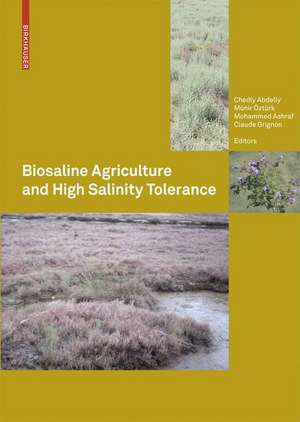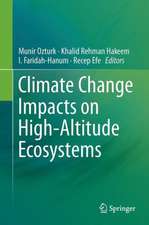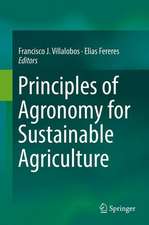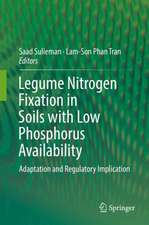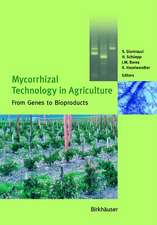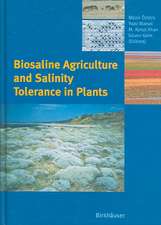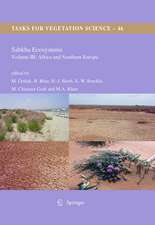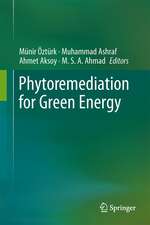Biosaline Agriculture and High Salinity Tolerance
Editat de Chedly Abdelly, Münir Öztürk, Muhammad Ashraf, Claude Grignonen Limba Engleză Hardback – 13 mar 2008
This volume comprises three sections: physiology and biochemistry, ecology, and molecular biology. Thus, a systematic approach has been adopted to uncover plant responses to various ecological factors at physiological and molecular levels.
It is of interest to students, researchers and professionals in plant physiology, molecular biology, biotechnology, agriculture, soil science, and environmental biology.
Preț: 1061.41 lei
Preț vechi: 1396.59 lei
-24% Nou
Puncte Express: 1592
Preț estimativ în valută:
203.09€ • 212.07$ • 167.71£
203.09€ • 212.07$ • 167.71£
Carte tipărită la comandă
Livrare economică 11-17 aprilie
Preluare comenzi: 021 569.72.76
Specificații
ISBN-13: 9783764385538
ISBN-10: 3764385537
Pagini: 310
Ilustrații: XVIII, 370 p. 102 illus.
Dimensiuni: 165 x 235 x 26 mm
Greutate: 0.84 kg
Ediția:2008
Editura: Birkhäuser Basel
Colecția Birkhäuser
Locul publicării:Basel, Switzerland
ISBN-10: 3764385537
Pagini: 310
Ilustrații: XVIII, 370 p. 102 illus.
Dimensiuni: 165 x 235 x 26 mm
Greutate: 0.84 kg
Ediția:2008
Editura: Birkhäuser Basel
Colecția Birkhäuser
Locul publicării:Basel, Switzerland
Public țintă
ResearchCuprins
Physiology and biochemistry.- Survival at extreme locations: Life strategies of halophytes - The long way from system ecology, whole plant physiology, cell biochemistry and molecular aspects back to sustainable utilization at field sites.- Growth enhancement in two potential cereal crops, maize and wheat, by exogenous applicationation of glycinebetaine.- In vitro tissue culture approaches for the study of salt stress in citrus.- Seawater effects on antioxidant production in berries of three cultivars of tomato (Lycopersicon esculentum mill.).- Identification of morphological, biochemical and physiological parameters for characterizing nutritional stress status in arboreous species differently tolerant to chlorosis.- Seawater irrigation: Effects on growth and nutrient uptake of sunflower plants.- Diversity in the response of two potential halophytes (Batis maritima and Crithmum maritimum) to salt stress.- Differential effects of sodium salts on the germination of a native halophytic species from South America: Prosopis strombulifera (Lam.) Benth.- Growth and nitrogen-fixing performances of medicago truncatula-Sinorhizobium meliloti symbioses under salt (NaCl) stress: Micro- and macro-symbiont contribution into symbiosis tolerance.- Physiological responses of two arabidopsis thaliana isolates, N1438 and Col, to different salts.- Physiology of salt tolerance in Atriplex halimus L..- Comparison of salinity tolerance of two related subspecies of Beta vulgaris: The sea beet (Beta vulgaris ssp. maritima) and the sugar beet (Beta vulgaris ssp. vulgaris).- Salinity influence on soil microbial population metabolism and enzymatic activities in lysimeter-grown Olea europaea and Nicotiana glauca.- Ecology.- Halophyte plant diversity in the Irano-Turanian phytogeographical region ofTurkey.- Potential use of halophytes with emphasis on fodder production in coastal areas of Pakistan.- Role of seed banks in the dynamics of desert communities.- Study of kochia (Kochia scoparia) as a forage crop.- Biodiversity of plant species and adaptation to drought and salt conditions. Selection of species for sustainable reforestation activity to combat desertification.- Potentiality of salt marshes in Mediterranean coastal zone of Egypt.- Studies on the halophyte desert vegetation in the Northern Caspian Region (Caspian Lowland and Mangyshlak).- Halophyte utilization for biodiversity and productivity of degraded pasture restoration in arid regions of Central Asia and Russia.- Selection of a halophyte that could be used in the bioreclamation of salt-affected soils in arid and semi-arid regions.- New approaches for biosaline agriculture development, management and conservation of sandy desert ecosystems.- Computer supported system for the risk assessment and action recommendation for the water objects in Uzbekistan based on the already developed databank.- Molecular biology.- Functional genomics to discover genes for salt tolerance in annual and perennial plants.- Molecular analyses of a dehydration-related gene from the DREB family in durum, wheat and triticale.- Expression analysis of salt stress responsive genes in grapevines.- Molecular biology and transport properties of grapevine Na+/H+ antiporter.- Opposite lipid signaling pathways tightly control proline accumulation in Arabidopsis thaliana and Thellungiella halophila.- Cadmium and copper genotoxicity in plants.- Effect of salinity on growth, leaf-phenolic content and antioxidant scavenging activity in Cynara cardunculus L..- Closing remarks.- Contributions to the 2006 meeting on sustainable utilization ofcash crop halophytes in Tunis.
Textul de pe ultima copertă
A major threat to agricultural productivity worldwide is undoubtedly due to environments with stressful factors including drought, salinity, waterlogging, extreme temperatures, non-optimal levels of mineral nutrients etc. Based on contributions presented at the International Conference on Biosaline Agriculture and High Salinity Tolerance in November 2006 in Gammarth, Tunisia, this book reviews the current state of knowledge in biosaline agriculture and high salinity tolerance in plants. It mainly focuses on the biotic approach to economically utilize the stress-prone areas by growing resistant plants.
This volume comprises three sections: physiology and biochemistry, ecology, and molecular biology. Thus, a systematic approach has been adopted to uncover plant responses to various ecological factors at physiological and molecular levels.
It is of interest to students, researchers and professionals in plant physiology, molecular biology, biotechnology, agriculture, soil science, and environmental biology.
This volume comprises three sections: physiology and biochemistry, ecology, and molecular biology. Thus, a systematic approach has been adopted to uncover plant responses to various ecological factors at physiological and molecular levels.
It is of interest to students, researchers and professionals in plant physiology, molecular biology, biotechnology, agriculture, soil science, and environmental biology.
Caracteristici
Supported by UNESCO Doha, Qatar International authorship Complements the volume M. Öztürk/Y. Waisel/M. Ajmal Khan/G. Görk, Biosaline Agriculture and Salinity Tolerance in Plants. 2006, Birkhäuser Publishing Includes supplementary material: sn.pub/extras
